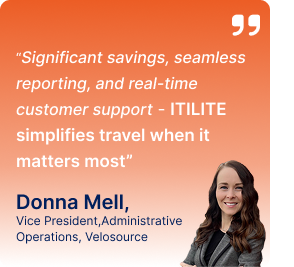
When it comes to managing expenses during travel, businesses often face a choice: corporate cards vs. reimbursement. This blog explores the two options, delving into the advantages and drawbacks of each. Without further ado, let’s dive into it.
What are Corporate Cards?
Corporate cards are specialized payment cards issued to employees by companies for business-related expenses. These cards streamline the financial aspects of corporate transactions. Unlike personal credit cards, corporate cards are designated for business purposes only.
These cards allow employees to make authorized purchases, cover travel expenses, and manage other business-related costs. They come with preset spending limits, allowing companies to control budgets and prevent excessive spending.
One notable feature of corporate cards is the ability to track and categorize expenses in real-time. This transparency ensures that companies have immediate visibility into their financial outflows. Corporate cards often integrate with expense management systems, automating the tracking and reporting processes.
Additionally, corporate cards contribute to policy enforcement. Companies can set specific spending policies and restrictions, and the cards automatically validate transactions against these policies. This automation minimizes non-compliance risk, providing a secure and controlled financial framework for business operations.
The centralized corporate card billing system simplifies finance teams’ reconciliation process. Instead of dealing with multiple individual expense reports, all business-related transactions are consolidated into a single statement.
In summary, corporate cards are tailored financial tools designed to simplify and regulate business-related transactions, offering transparency, control, and efficiency in managing corporate expenses.
Corporate Cards Vs. Reimbursements
This section on corporate cards vs. reimbursement reveals important differences in how companies handle business expenses. Corporate cards are like special credit cards for work-related costs. They help control spending by setting limits in advance, avoiding overspending.
Reimbursements, on the other hand, work differently. Employees pay for work expenses first and get repaid later. This can take time, causing delays and making things financially tough for employees.
Corporate cards have a big advantage in keeping things clear and immediate. They show expenses in real-time, helping companies make quick decisions and adjust budgets as needed. Reimbursements lack this quickness, relying on looking back after the spending is done.
An important element of the debate, corporate cards vs. reimbursement, is adherence to company spending rules. Corporate cards are more reliable. They have automatic checks to ensure spending fits company policies. Reimbursements, however, need manual checking, making it harder to enforce spending rules consistently.
Corporate cards also make it easier for the finance team. All the spending details are in one place, making checking and managing expenses quicker and simpler. Reimbursements involve going through many separate reports, making it more time-consuming for the finance team.
The debate of corporate cards vs. reimbursement can’t miss out on rewards. Corporate cards often come with rewards, like getting money back for work-related spending. This not only benefits employees but also saves money for the company. Reimbursements don’t offer this extra perk, missing out on a chance to make spending a bit more rewarding.
When employees travel, corporate cards often include travel-related perks. This can be things like access to airport lounges or travel insurance. These perks make the travel experience better for employees. Reimbursements usually don’t come with these extra benefits.
Moreover, corporate cards promote a company’s image. A corporate card with the company’s name looks more professional than employees using their personal money and waiting for reimbursements. It creates a better impression for clients and partners.
In conclusion, looking at corporate cards and reimbursements shows that corporate cards offer better control over budgets, immediate tracking of spending, consistent policy enforcement, simple money management, and additional rewards.
Features of a Corporate Card
A good corporate travel card is a valuable asset for businesses. Here are key features that make it to the list of the best corporate cards:
1. Smart Spending Controls:
A reliable corporate travel card comes with smart spending controls, allowing companies to set specific spending limits for each card. This feature helps prevent overspending and ensures adherence to the company’s budgetary constraints.
2. Real-time Expense Tracking:
The ability to track expenses in real time is a standout feature. A good corporate travel card provides instant visibility into transactions, enabling both employees and finance teams to monitor spending promptly.
3. Automated Policy Enforcement:
Corporate travel cards automate policy enforcement, ensuring all transactions align with the company’s spending policies. Automated checks minimize the risk of non-compliance.
4. Integration with Expense Management Systems:
Seamless integration with expense management systems is crucial. A good corporate travel card syncs effortlessly with these systems, streamlining the reconciliation process. This integration minimizes manual effort and reduces errors.
5. Comprehensive Reporting and Analytics:
The provision of comprehensive reporting and analytics tools is essential. A good corporate travel card generates detailed reports on spending patterns, allowing businesses to analyze expenses, identify trends, and make informed decisions.
How to Choose the Right Corporate Card?
Great! In the battles of corporate cards vs. reimbursement, the former won. Now, learn how to choose one of the best corporate cards. Here’s a simple 5-step process to guide you:
1. Evaluate Business Needs
Start by assessing your company’s specific requirements. Consider the nature of your business, the frequency of travel, and the typical expenses incurred.
2. Research Available Options
Conduct thorough research on available corporate card options. Look for providers that offer features tailored to your business requirements. Consider spending controls, real-time tracking, integration capabilities, and additional perks or rewards programs.
3. Compare Terms and Fees
Carefully compare the terms and fees associated with different corporate cards. Pay attention to interest rates, annual fees, and any additional charges.
4. Check Policy Enforcement Mechanisms
Evaluate the policy enforcement mechanisms of each corporate card. Ensure that the card automates policy checks, helping maintain spending discipline and adherence to company policies. This feature is crucial for minimizing the risk of non-compliance.
5. Review User Feedback
Before finalizing your decision, review user feedback and testimonials. Insights from other businesses can provide valuable perspectives on the practicality and effectiveness of a particular corporate card. Look for cards with positive reviews and a track record of reliability.
Travel with Itilite Corporate Cards
I hope we answered all your questions on “ corporate cards vs. reimbursement.” If you’re looking for one of the best corporate cards, try itilite.
Here are some of the perks you enjoy:
- Pre-set spending limits
- Real-time tracking
- Automated policy enforcement
- Integration with expense management systems
- Airport lounge access
- Rewards programs
To know more, book a quick demo with us.












